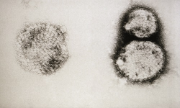Pathogen and transmission
Hantaviruses are one of the pathogens of viral haemorrhagic fever. The virus is named after the Hantan River in South Korea, where more than 3,000 troops fell seriously ill after becoming infected with it during the 1950-1953 Korean War. The hantavirus is transmitted to humans by infected rodents (such as mice and rats), which excrete it in their saliva, urine and faeces. Infection can occur through rodent bite, through contact with a rodent or its excretions or from ingesting contaminated dust.
There are many types of hantavirus, which vary in their geographical spread and their pathologies. Human-to-human transmission has only been observed with one single virus type, which is extremely rare.
Pathology
Most cases of hantavirus infection pass unnoticed. If symptoms do occur, they can, depending on the virus type, lead to any of a range of severe pathologies all the way to haemorrhagic fever: very high temperatures with a tendency to bleeding. Initial symptoms are usually a sudden high fever that lasts three to four days, accompanied by unspecified flu-like symptoms such as headache and stomach and muscle pains.
The time period between infection and the first clinical symptoms can vary, but is generally between one and five weeks. There is no effective medication to treat hantavirus infection, so treatment is limited to easing the symptoms thereof.
The types of hantavirus found in Europe and Asia may lead to haemorrhagic fever with renal syndrome (HFRS), which can result in kidney function disorder or even acute kidney failure. Some 1 to 15 per cent of HFRS cases are fatal. The types of hantavirus found in the Americas can cause haemorrhagic fever with (cardio)pulmonary syndrome (HCPS or HPS), pulmonary oedema or acute respiratory failure as possible complications. Up to 50 per cent of these cases are fatal.
Distribution and frequency of occurrence
Hantaviruses are found all over the world. Some 3,000 cases of hantavirus infections per year have been reported in Europe since 2000. Hardly any of these have been in Switzerland, however. Germany, Finland, Austria and Slovenia have recorded the highest numbers of such cases. Case numbers for Germany also show sizeable fluctuations: while the annual average is some 230 infected persons, 2012 saw a bigger hantavirus outbreak in the country that affected some 3,000 individuals. In Europe, severe cases of hantavirus infection with life-threatening bleeding are extremely rare.
Prevention
There is no vaccine against hantavirus infection. The only way to minimise the risk of such infection is to avoid contact with rodents and their excreta.
For further information on the global distribution of hantavirus infections and ways and means to avoid this, consult your GP or a doctor specialising in travel medicine (see also HealthyTravel).


